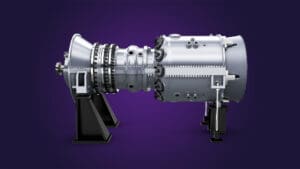The US Department of Energy’s (DOE) Office of Fossil Energy and Carbon Management (FECM) has announced US$4.7 million in funding for six projects to advance the development of ceramic-based materials to improve the efficiency of hydrogen-fueled turbines that may one day be used in clean power plants. Electricity made from clean hydrogen — whether produced from renewable resources or from fossil fuels or carbon-based waste resources, coupled with pre-combustion carbon capture and storage — will help achieve the Biden-Harris Administration’s goal of a zero-carbon US power sector by 2035.
The FECM funds research, development, demonstration, and deployment projects to decarbonize power generation and industrial production, remove carbon dioxide from the atmosphere, and mitigate the environmental impacts of fossil fuel production and use. Priority areas of technology work include carbon capture, carbon conversion, carbon dioxide removal, carbon dioxide transport and storage, hydrogen production with carbon management, methane emissions reductions, and critical minerals production.
“Investing in research and development to increase hydrogen turbine efficiency will not only help bring down electricity costs but can ultimately help to ramp up the use of hydrogen as a low-carbon fuel for power production, providing cleaner energy for all Americans,” said Brad Crabtree, assistant secretary of FECM.
The DOE’s National Energy Technology Laboratory (NETL) will manage the projects, which will focus on the research and development of ceramic matrix composite (CMC) components, which allow hydrogen turbines to operate at higher working temperatures, ultimately improving cycle efficiency. Specifically, this research and development will enable operation at 302°F (150°C) higher than current CMC technology and 842°F (450°C) higher than existing nickel-based materials allow, while reducing the amount of cooling air required. According to the DOE, these improvements will lead to increased turbine efficiency, ultimately resulting in reduced electricity costs, as well as lower greenhouse gas emissions as clean hydrogen displaces natural gas as the turbine fuel.
The projects receiving funding are:
Accelerated Discovery Of Protection System And Laser Processing Of Protective Coatings On CMC For Hydrogen Turbines
DOE Funding: US$799,998
Clemson University will partner with Siemens Energy and Advanced Manufacturing LLC to overcome the challenges of high-temperature and harsh-gas environments in hydrogen-fueled turbines by developing high-performance coatings to improve the performance of silicon carbide fiber-reinforced silicon carbide (SiCf/SiC) CMCs. The overall goal of this project is to design, process, and validate the laser-manufactured, integrated, and graded bond coat (environmental barrier coat) thermal barrier coat system that can protect and lead to the use of SiCf/SiC matrix CMCs in next-generation hydrogen-fueled turbines.

Enhancing CMC Temperature Performance In High Hydrogen Environments Using Field-Assisted Sintering Technology
DOE Funding: US$675,000
Pennsylvania State University intends to improve the temperature performance of CMC materials in high-hydrogen environments using field assisted sintering technology (FAST) to manufacture CMCs. FAST processing, also known as spark plasma sintering, opens the processing design landscape to rapidly manufacture dense, low-porosity, ultra-high temperature CMCs in a fraction of the time traditionally required to fabricate CMCs.
Water Vapor Resistant SiC/SiC Composite For Hydrogen-Based Turbines
DOE Funding: US$799,673
Raytheon Technologies Corporation — Pratt & Whitney Division plans to develop a 2700°F (1482°C)-class SiC/SiC CMC with enhanced water vapor resistance as an enabling technology for future hydrogen turbine engine hot section components applicable to both industrial and aero gas turbines, using mixed fuels or pure hydrogen. A new polycrystalline SiC fiber with improved thermal stability will be introduced, as well as a modified fiber interface coating to enhance the resistance to oxidation and more specifically to water vapor.
Predictive Modeling Investigating Steam-Mediated Degradation Of Environmental Barrier Coatings In Hydrogen-Fueled Turbines (PREMISE)
DOE Funding: US$799,490
The Raytheon Technologies Research Center, in collaboration with University of Virginia, plans to develop predictive models that describe steam-mediated degradation of a CMC system that has been under development, in hydrogen and hydrogen-natural gas mixture-fueled turbines. These predictive models will enable the design of CMC components in future hydrogen turbine engine hot-section components, applicable to both industrial and aero gas turbines, using hydrogen and mixed fuels.
Ceramic Matrix Composites For Hydrogen Combustion
DOE Funding: US$798,964
The University of Central Florida Board of Trustees will partner with the University of Miami to explore the design, manufacture, and testing of a combustor liner made of a novel CMC material with a molecularly assembled multi-layered nano-ceramic coating in a hydrogen combustor reminiscent of modern gas turbine combustors. This project will methodically explore and generate CMC material performance data and experience to advance hydrogen-based energy production with zero carbon emissions.
Development Of Hetero-Multilayered Ceramic Thermal Barrier Coatings For Hydrogen Turbines For Stationary Power Generation
DOE Funding: US$800,000
The University of Maryland plans to develop a thermal barrier coating composed of a novel CMC material with desired thermal, thermomechanical, and moisture resistance properties to meet the goal of a 302°F to 392°F (150°C to 200°C) increase to the operational capabilities of CMCs at higher moisture contents in the combustor and turbine hot gas path. The multilayer thermal barrier coating will provide a potential of around 392°F (200°C) or 15% increase in temperature performance compared to the current state-of-the-art temperature capability.

















